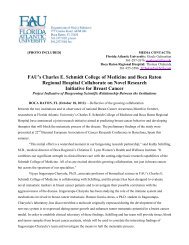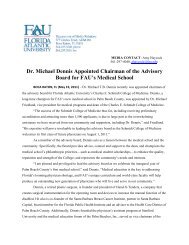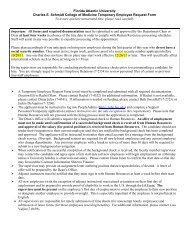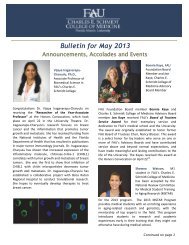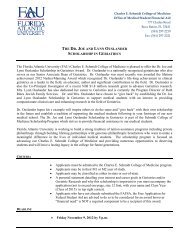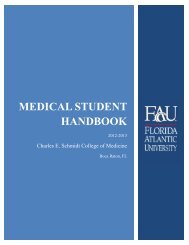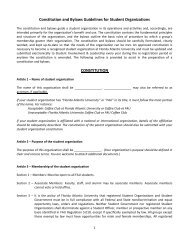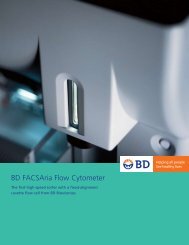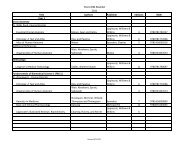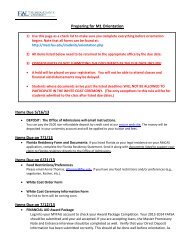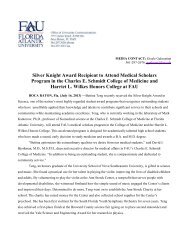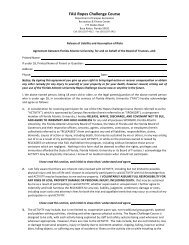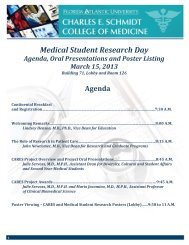Student Handbook - College of Medicine - Florida Atlantic University
Student Handbook - College of Medicine - Florida Atlantic University
Student Handbook - College of Medicine - Florida Atlantic University
You also want an ePaper? Increase the reach of your titles
YUMPU automatically turns print PDFs into web optimized ePapers that Google loves.
Ac. Excessive use <strong>of</strong> fragrances should be avoided, as some people may be sensitive to scented chemicals.d. Hair should be neat and clean. Hairstyle and/or color should not interfere with assigned duties or present aphysical hazard to the patient, to the student, or to another person.e. Fingernails should be clean and <strong>of</strong> short to medium length. <strong>Student</strong>s may not have acrylic nails whileproviding patient care services.2. Standards in the classroom settinga. For men, a shirt with a collar is preferred.b. For women, shirts and blouses must extend to the waistband <strong>of</strong> the skirt or pants.c. <strong>Student</strong>s are permitted to wear casual slacks, jeans, and T-shirts, provided they are clean, in good repair,and do not contain any <strong>of</strong>fensive language or pictures. Shorts are not permitted.3. Standards in the laboratory settinga. <strong>Student</strong>s should follow the guidelines as established for the classroom setting.b. OSHA regulations prohibit open-toed shoes.4. Standards in the clinical care settinga. Pr<strong>of</strong>essional attire and physician-identifying clothing:o Men should wear a shirt, tie, long pants, socks, and hard-soled shoes.o Women should wear dresses or skirts <strong>of</strong> medium length, or pr<strong>of</strong>essional style slacks.o A white coat with the FAU <strong>College</strong> <strong>of</strong> <strong>Medicine</strong> embroidered logo and a name badge are required.o Shoes must be comfortable, clean, in good repair and appropriate to the job and duties. In addition,specific footwear requirements, such as steel-toed shoes, may be defined in areas with specialsafety concerns. Beach-type shoes (such as thongs or flip-flops) and bedroom slippers are notappropriate.o <strong>Student</strong>s should not chew gum.Note: While wearing a white coat in the clinical setting, medical students are also expected to identify themselves asstudents at all times and must assume responsibility to clarify their role to patients.5. Standards for home visitsa. The same as the guidelines for the clinical care setting, except students should not wear white coats orbadges when making home visits.b. In general, the dress should be casual pr<strong>of</strong>essional attire that fits in with community standards and does notdraw attention to the student.c. The dress guidelines for the home visits will be reviewed in more detail as a part <strong>of</strong> the coursework inpreparation for the first home visits.6. Additional guidelinesa. Jewelry (e.g., necklaces, rings, earrings, bracelets, etc.) and other fashion accessories should beappropriate and not interfere with assigned duties. Jewelry represents a potential for infection and loosejewelry can be grabbed, causing a potential physical hazard to the student or the patient.b. Tattoos and body art with wording or images that may be perceived as <strong>of</strong>fensive should be covered duringthe time <strong>of</strong> pr<strong>of</strong>essional contact with patients and families. Some examples <strong>of</strong> such <strong>of</strong>fensive art or imagesinclude racial slurs, swear words, symbols <strong>of</strong> death, or inappropriate revealing <strong>of</strong> body parts in a way that areasonable person could perceive as inappropriate.7. Hospital attire (scrubs)a. In general, medical students should wear their own clothes (rather than scrubs) for patient care assignmentsin clinics and when performing inpatient services.b. Scrubs must be worn in compliance with the policies <strong>of</strong> the institution in which the medical student isassigned for patient care rotations. They should never be worn in public places outside <strong>of</strong> the clinical carefacility.c. Scrubs may be worn in specific patient care areas only. If scrubs must be worn outside <strong>of</strong> the designatedclinical area, they should be covered with a white coat.d. Scrubs should not be taken home without prior written authorization from the providing institution.e. Hair covers, masks, shoe covers, and gowns should be removed before leaving the designated clinicalareas and should not be worn while in the outpatient clinics or when making rounds on the inpatientservices.8. Examples <strong>of</strong> inappropriate attire in the clinical setting include, but are not limited to, the following:29



